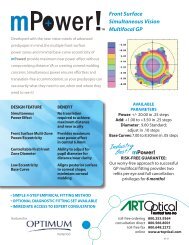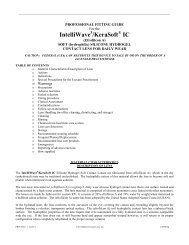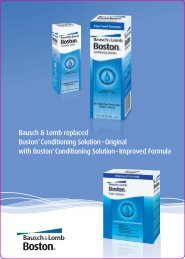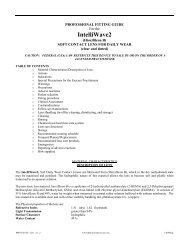Acofilcon B - Art Optical Contact Lens, Inc.
Acofilcon B - Art Optical Contact Lens, Inc.
Acofilcon B - Art Optical Contact Lens, Inc.
You also want an ePaper? Increase the reach of your titles
YUMPU automatically turns print PDFs into web optimized ePapers that Google loves.
PACKAGE INSERT<br />
For the IntelliWave1 (<strong>Acofilcon</strong> B) SOFT CONTACT LENS FOR DAILY WEAR (clear and tinted)<br />
CAUTION: FEDERAL (USA) LAW RESTRICTS THIS DEVICE TO SALE BY OR ON THE ORDER OF A LICENSED PRACTITIONER.<br />
IMPORTANT<br />
Please read carefully and keep this information for future use. This package insert is intended for the eyecare practitioner, but should be made available to the patient upon request. The eyecare practitioner<br />
should provide the patient with the wearer’s guide that pertains to the patients prescribed lens.<br />
DESCRIPTION<br />
The IntelliWave1 Soft Daily Wear <strong>Contact</strong> <strong>Lens</strong>es are fabricated from (<strong>Acofilcon</strong> B), which in the dry (unhydrated) state may be machined and polished. The hydrophilic nature of these materials allows<br />
the lens to become soft and pliable when immersed in an aqueous solution. The non-ionic lens material, (acofilcon B) is a terpolymer based on high purity Glycerol Methacrylate 2,3-Dihydroxypropyl<br />
Methacrylate (GMA), with N-vinyl-2-pyrrolidone (NVP), methyl methacrylate (MMA), and 2-hydroxyethyl methacrylate (2-HEMA) and cross-linked with Diallyl Maleate (DAM). It consists of 51%<br />
acofilcon B and 49% water by weight when immersed in normal saline solution buffered with sodium bicarbonate. The lens material is available in clear and with a blue visibility-handling tint, Color<br />
additive ‘Reactive Blue 4’ 21 CFR part 73.2121.<br />
The Physical properties of the lens are: The IntelliWave1, Soft Daily Wear <strong>Contact</strong> <strong>Lens</strong> parameters:<br />
Refractive Index 1.52 (dry) 1.42 (hydrated) Base Curve: 7.0mm - 10.0mm<br />
Light Transmission greater than 94% Power: +20.00D to -20.00D<br />
Surface Character hydrophilic Cylinder: -0.75D to -12.00D<br />
Water Content 49 % Add Power: +0.25D to +4.00D<br />
Specific Gravity 1.142 (hydrated)<br />
Oxygen Permeability 15.89 X 10<br />
Diameter: 13.0mm - 14.5mm<br />
-11<br />
(cm 2<br />
/sec) (ml O /ml x hPa @ 35<br />
2 o<br />
C) (revised Fatt method)<br />
In the hydrated state, the lens conforms to the curvature of the eye covering the cornea and extending slightly beyond the limbus forming a colorless, transparent optical surface. The IntelliWave1, Soft<br />
Daily Wear <strong>Contact</strong> <strong>Lens</strong> has a spherical back surface. The hydrophilic properties of the lens require that it be maintained in a fully hydrated state in a solution compatible with the eye. If the lens dries<br />
out, it will become hard and appear somewhat warped however, it will return to its proper configuration when completely rehydrated in the proper storage solution.<br />
ACTIONS<br />
In its hydrated state, the IntelliWave1, Soft Daily Wear <strong>Contact</strong> <strong>Lens</strong> (<strong>Acofilcon</strong> B), when placed on the cornea, act as a refracting medium to focus light rays on the retina.<br />
CAUTION<br />
Due to the small number of patients enrolled in clinical investigation of lens, all refractive powers, design configurations, or lens parameters available in the lens material are not evaluated in significant<br />
numbers. Consequently, when selecting an appropriate lens design and parameters, the eyecare practitioner should consider all characteristics of the lens that can affect lens performance and ocular health,<br />
including oxygen permeability, wettability, central and peripheral thickness, and optic zone diameter. The potential impact of these factors on the patient's ocular health must be carefully weighed against<br />
the patient's need for refractive correction therefore, the continuing ocular health of the patient and lens performance on the eye should be carefully monitored by the prescribing eyecare practitioner.<br />
INDICATIONS<br />
o The IntelliWave1, Sphere (<strong>Acofilcon</strong> B) Soft <strong>Contact</strong> <strong>Lens</strong>es for daily wear are indicated for the correction of visual acuity in aphakic and not aphakic persons with non-diseased eyes with myopia<br />
or hyperopia. The lens may be worn by persons who exhibit refractive astigmatism of .75 diopters or less where the astigmatism does not interfere with visual acuity.<br />
o The IntelliWave1, Toric (<strong>Acofilcon</strong> B) Soft <strong>Contact</strong> <strong>Lens</strong>es for daily wear are indicated for the correction of visual acuity in aphakic and not aphakic persons with non-diseased eyes with myopia or<br />
hyperopia and/or possesses refractive astigmatism not exceeding 12.00 diopters.<br />
o The IntelliWave1, Multifocal (<strong>Acofilcon</strong> B) Soft <strong>Contact</strong> <strong>Lens</strong>es for daily wear are indicated for the correction of visual acuity in aphakic and not aphakic persons with non-diseased eyes with<br />
myopia or hyperopia and/or possesses refractive astigmatism of .75 diopters or less where the astigmatism does not interfere with visual acuity and are presbyopic requiring add power of up to +4.00<br />
diopters.<br />
o The IntelliWave1, Multifocal Toric (<strong>Acofilcon</strong> B) Soft <strong>Contact</strong> <strong>Lens</strong>es for daily wear are indicated for the correction of visual acuity in aphakic and not aphakic persons with non-diseased eyes with<br />
myopia or hyperopia and/or possesses refractive astigmatism not exceeding 5 diopters and are presbyopic requiring add power of up to +4.00 diopters.<br />
Eyecare practitioners may prescribe the lenses for frequent/planned replacement wear, with cleaning, disinfection and scheduled replacement. When prescribed for frequent/planned replacement wear, the<br />
lens may be cleaned and disinfected using a chemical (not heat) lens care system.<br />
CONTRAINDICATIONS (REASONS NOT TO USE)<br />
DO NOT USE the IntelliWave1, Soft Daily Wear <strong>Contact</strong> <strong>Lens</strong> (<strong>Acofilcon</strong> B) <strong>Contact</strong> <strong>Lens</strong> when any of the following conditions are present:<br />
* Acute and subacute inflammation or infection of the anterior chamber of the eye.<br />
* Any eye disease, injury, or abnormality that affects the cornea, conjunctiva, or eyelids.<br />
* Severe insufficiency of lacrimal secretion (dry eyes).<br />
* Corneal hypoesthesia (reduced corneal sensitivity), if not-aphakic.<br />
* Any systemic disease that may affect the eye or be exaggerated by wearing contact lens.<br />
* Allergic reactions of ocular surfaces or adnexa that may be induced or exaggerated by wearing contact lens or use of contact lens solutions.<br />
* Allergy to any ingredient, such as mercury or thimerosal, in a solution which is to be used to care for the IntelliWave1, Soft Daily Wear <strong>Contact</strong> <strong>Lens</strong>.<br />
* Any active corneal infection (bacterial, fungi, or viral)<br />
* If eyes become red or irritated.<br />
* Patients unable to follow lens care regimen or unable to obtain assistance to do so.<br />
WARNINGS<br />
* PROBLEMS WITH CONTACT LENS AND LENS CARE PRODUCTS COULD RESULT IN SEROUS INJURY TO THE EYE. It is essential that patients follow their eyecare<br />
practitioner's direction and all labeling instructions for proper use of lens and lens care products, including the lens case. EYE PROBLEMS, INCLUDING CORNEAL ULCERS, CAN<br />
DEVELOP RAPIDLY AND LEAD TO LOSS OF VISION; THEREFORE, IF YOU EXPERIENCE EYE DISCOMFORT, EXCESSIVE TEARING, VISION CHANGES, OR<br />
REDNESS OF THE EYE, IMMEDIATELY REMOVE YOUR LENS AND PROMPTLY CONTACT YOUR EYECARE PRACTITIONER.<br />
* All contact lens wearers must see their eyecare practitioner as directed.<br />
* Daily wear lens are not indicated for overnight wear, and patients should be instructed not to wear lens while sleeping. Clinical studies have shown that the risk of serious adverse<br />
reactions is increased when this lens is worn overnight.<br />
* Studies have shown that contact lens wearers who are smokers have a higher incidence of adverse reactions than nonsmokers do.<br />
PRECAUTIONS<br />
Special Precautions for the Eyecare Practitioner<br />
Due to the small number of patients enrolled in clinical investigation of lens, all refractive powers, design configurations, or lens parameters available in the lens material were not evaluated in significant<br />
numbers. Consequently, when selecting an appropriate lens design and parameters, the eyecare practitioner should consider all characteristics of the lens that can affect lens performance and ocular health,<br />
including oxygen permeability, wettability, central and peripheral thickness, and optic zone diameter. The potential impact of these factors on the patient's ocular health must be carefully weighed against<br />
the patient's need for refractive correction. Therefore, the continuing ocular health of the patient and lens performance on the eye should be carefully monitored by the prescribing eyecare practitioner.<br />
* Patients who wear aspheric contact lenses to correct presbyopia may not achieve the best corrected visual acuity for either far or near vision. Visual requirements vary with the<br />
individual and should be considered when selecting the most appropriate type of lens for each patient<br />
* Fluorescein, a yellow dye, should not be used while the lens is on the eye. The lens absorb this dye and become discolored. Whenever Fluorescein is used in eyes, the eyes should be<br />
flushed with a sterile saline solution that is recommended for in eye use. Wait at least one hour before replacing the lens. Too early replacement may allow the lens to absorb residual<br />
Fluorescein irreversibly.<br />
* Before leaving the eyecare practitioner's office, the patient should be able to promptly remove lens or should have someone else available who can remove the lens for him or her.<br />
* Eyecare practitioners should instruct the patient to remove the lens immediately if the eye becomes red or irritated. Eyecare practitioners should carefully instruct patients about the<br />
following care regimen and safety precautions:<br />
* Different solutions cannot always be used together, and not all solutions are safe for use with all lens. Use only recommended solutions that are fresh and sterile. Never use solutions<br />
recommended for conventional hard contact lens only. Chemical disinfection solutions should not be used with heat. Always use FRESH, STERILE UNEXPIRED lens care solutions.<br />
Always follow directions in the package inserts for the use of contact lens solutions. Sterile unpreserved solutions, when used, should be discarded after the time specified in the labeling<br />
directions. Do not use saliva or anything other than the recommended solution for lubricating or rewetting lens. Always keep the lens completely immersed in the recommended storage<br />
solution when the lens is not being worn (stored). Prolonged periods of drying will damage the lens. Follow the lens care directions for (Care for a Dried Out Dehydrated Dry <strong>Lens</strong>) if<br />
the lens surface does become dried out.<br />
* If the lens sticks (stops moving) on the eye, follow the recommended directions on (care for sticking non-moving lens). The lens should move freely on the eye for the continued health<br />
of the eye. If nonmovement of the lens continues, the patient should be instructed to IMMEDIATELY consult his or her eyecare practitioner.<br />
* Always wash and rinse hands before handling lens. Do not get cosmetics, lotions, soaps, creams, deodorants, or sprays in the eyes or on the lens. It is best to put on lens before putting<br />
on makeup. Water-base cosmetics are less likely to damage lens than oil-base.<br />
* Do not touch contact lens with the fingers or hands if the hands are not free of foreign materials, as microscope scratches of the lens may occur, causing distorted vision and/or injury to<br />
the eye.<br />
* Carefully follow the handling, insertion, removal, cleaning, disinfection, storing and wearing instructions in the patient instructions for the IntelliWave1, Soft Daily Wear <strong>Contact</strong> <strong>Lens</strong><br />
and those prescribed by the eyecare practitioner.<br />
* Never wear lens beyond the period recommended by the eyecare practitioner.<br />
* If aerosol products such as hair spray are used while wearing lens, exercise caution and keep eyes closed until the spray has settled.<br />
* Always handle lens carefully and avoid dropping them.<br />
* Avoid all harmful or irritating vapors and fumes while wearing lens.<br />
* Ask the eyecare practitioner about wearing lens during sporting activities.<br />
* Inform the doctor (health care practitioner) about being a contact lens wearer.<br />
* Never use tweezers or other tools to remove lens from the lens container unless specifically indicated for that use. Pour the lens into the hand.<br />
* Do not touch the lens with fingernails.<br />
* Always discard lenses worn on a frequent replacement schedule after the recommended wearing schedule prescribed by the eyecare practitioner.<br />
* Always contact the eyecare practitioner before using any medicine or medications in the eyes.<br />
* Always inform the employer of being a contact lens wearer. Some jobs may require use of eye protection equipment or may require that the patient not wear contact lens.<br />
* As with any contact lens, follow-up visits are necessary to assure the continuing health of the patient's eyes. The patient should be instructed as to a recommended follow-up schedule.<br />
ADVERSE REACTIONS<br />
The patient should be informed that the following problems may occur:<br />
* Eyes stinging, burning, itching (irritation), or other eye pain.<br />
* Comfort is less than when lens was first placed on eye.<br />
* Feeling that something is in the eye such as a foreign body or scratched area.<br />
* Excessive watering (tearing) of the eye.<br />
* Unusual eye secretions.<br />
* Redness of the eye.<br />
* Reduced sharpness of vision (poor visual acuity).<br />
* Blurred vision, rainbows, or halos around objects.<br />
* Sensitivity to light (photophobia).<br />
* Dry eyes.<br />
PRINT DATE: 12/11 rev2 ©<strong>Art</strong> <strong>Optical</strong> <strong>Contact</strong> <strong>Lens</strong>, <strong>Inc</strong>. s:lb100.pi
If the patient notices any of the above, he or she should be instructed to:<br />
* IMMEDIATELY REMOVE LENS.<br />
* If discomfort or problems stops, then look closely at the lens. If the lens is in any damage, DO NOT PUT THE LENS BACK ON THE EYE. Place the lens in the storage case and<br />
contact the eyecare practitioner. If the lens has dirt, an eyelash, or other foreign body on it, or the problem stops and the lens appears undamaged, the patient should thoroughly clean,<br />
rinse, and disinfect the lens then reinsert them.<br />
* After reinsertion, if the problem continues, the patient should IMMEDIATELY REMOVE THE LENS AND CONSULT THE EYECARE PRACTITIONER.<br />
When any of the above problems occur, a serious condition such as infection, corneal ulcer, neovascularization, or iritis may be present. The patient should be instructed to KEEP<br />
LENS OFF THE EYE AND SEEK IMMEDIATE PROFESSIONAL IDENTIFICATION of the problem and prompt treatment to avoid serious eye damage.<br />
FITTING<br />
Conventional methods of fitting contact lens do and do not apply to the IntelliWave1, Soft Daily Wear <strong>Contact</strong> <strong>Lens</strong>. For a detailed description of the fitting techniques, refer IntelliWave1, Soft Daily<br />
Wear <strong>Contact</strong> <strong>Lens</strong> Professional Fitting and Information Guide, copies of which are available from:<br />
<strong>Art</strong> <strong>Optical</strong> <strong>Contact</strong> <strong>Lens</strong>, <strong>Inc</strong>.<br />
3175 3 Mile Road NW<br />
Walker, Michigan 49534<br />
Toll Free Number: 800-253-9364<br />
www.artoptical.com<br />
WEARING SCHEDULE<br />
THE WEARING AND REPLACEMENT SCHEDULES SHOULD BE DETERMINED BY THE EYECARE PRACTITIONER. Patients tend to over wear the lens initially. The eyecare<br />
practitioner should emphasize the importance of adhering to the initial maximum wearing schedule. Regular checkups, as determined by the eyecare practitioner, are also extremely important.<br />
The IntelliWave1, Soft Daily Wear <strong>Contact</strong> <strong>Lens</strong>es are indicated for daily wear. The maximum suggested wearing time for this lens is:<br />
DAY HOURS<br />
1 6<br />
2 8<br />
3 10<br />
4 12<br />
5 14<br />
6 All Waking hours *<br />
STUDIES HAVE NOT BEEN COMPLETED TO SHOW THAT THE IntelliWave1, Soft Daily Wear <strong>Contact</strong> <strong>Lens</strong> IS SAFE TO WEAR DURING SLEEP.<br />
* WEARING SCHEDULES SHOULD BE DETERMINED BY THE EYECARE PRACTITIONER.<br />
FREQUENT/PLANNED REPLACEMENT<br />
<strong>Art</strong> <strong>Optical</strong> recommends that the IntelliWave1, Soft Daily Wear <strong>Contact</strong> <strong>Lens</strong> be discarded and replaced with a new lens every six months. However, as the Eyecare practitioner, you are encouraged to<br />
determine an appropriate lens replacement schedule based upon the response of the patient.<br />
LENS CARE DIRECTIONS<br />
Eyecare practitioners should review with the patient lens care directions, including both basic lens care information and specific instructions on the lens care regimen recommended for the patient:<br />
Basic Instructions:<br />
o Care of contact lens takes very little time and involves THREE essential steps – CLEANING, RINSING AND DISINFECTING. Each step in itself is important, and one step is not to be replaced<br />
by the other. Always wash, rinse and dry hands before handling contact lens. Always use FRESH, STERILE UNEXPIRED lens care solutions. Use the recommended chemical (not heat) lens<br />
care system. Different solutions cannot always be used together, and not all solutions are safe for use with all lens. DO NOT ALTERNATE OR MIX LENS CARE SYSTEMS UNLESS<br />
INDICATED ON SOLUTION LABELING. Do not use saliva or anything other than the recommended solutions for lubricating or rewetting lens. Do not put lens in the mouth. <strong>Lens</strong> should be<br />
cleaned, rinsed, and disinfected each time they are removed. Cleaning and rinsing are necessary to remove mucus and film from the lens surface. Disinfecting is necessary to destroy harmful<br />
germs. The lens case must be emptied and refilled with fresh, sterile recommended storage and disinfection solution prior to disinfecting the lens. Eyecare practitioners may recommend a<br />
lubricating/rewetting solution, which can be used to wet (lubricate) lens while they are being worn to make them more comfortable. Note: Some solutions may have more than one function, which<br />
will be indicated on the label. Read the label on the solution bottle, and follow instructions.<br />
<strong>Lens</strong> cleaning, disinfection, and storage:<br />
o Clean one lens first (always the same lens first to avoid mix-ups), rinse the lens thoroughly with recommended rinsing or disinfecting solution to remove the cleaning solution, mucus, and film from<br />
the lens surface, and put lens into correct chamber of the lens storage case. Then repeat the procedure for the second lens. After cleaning, disinfect lens using the system recommended by the<br />
manufacture and/or the eyecare practitioner. To store lens, disinfect and leave them in the closed/unopened case until ready to wear. If lens is not to be used immediately following disinfection, the<br />
patient should be instructed to consult the package insert or the eyecare practitioner for information on storage of lens.<br />
<strong>Lens</strong> Case Cleaning and Maintenance:<br />
o <strong>Contact</strong> lens cases can be a source of bacteria growth. After removing the lens from the case, empty and rinse the lens storage case with solution as recommended by the lens case manufacture; then<br />
allow the lens case to air dry. When the case is used again, refill it with storage solution. Replace lens case at regular intervals as recommended by the lens case manufacture or your eyecare<br />
practitioner.<br />
<strong>Lens</strong> Care Regimen:<br />
o Patients must adhere to the lens care regimen recommended by their eyecare practitioner for the IntelliWave1, Soft Daily Wear <strong>Contact</strong> <strong>Lens</strong>. Failure to follow this procedure may result in<br />
development of serious ocular infections<br />
Care for a dried out (dehydrated) dry lens:<br />
o If for some reason, your lens dry out completely a minimum of handling is important, as they are very brittle in the dehydrated state. Carefully place them in rinsing or storage solution for a<br />
minimum of thirty minutes during which time they will become soft and flexible. Then follow the cleaning, rinsing, and disinfecting procedures - including soaking the lens in storage and<br />
disinfection solution for four hours before wearing again.<br />
Care for a sticking (non-moving) lens:<br />
o If the lens sticks (cannot be removed), the patient should be instructed to apply 3 to 4 drops of the recommended lubricating or rewetting solution directly to the eye and wait until the lens begins to<br />
move freely on the eye before removing it. If nonmovement of the lens continues after 15 minutes, the patient should IMMEDIATELY consult the eyecare practitioner.<br />
Storage:<br />
o The IntelliWave1, Soft Daily Wear <strong>Contact</strong> <strong>Lens</strong> must be stored only in the recommended solutions. If left exposed to the air, the lens will dehydrate. If lens dehydrates, reference above section<br />
on caring for dried out (dehydrated) dry lens.<br />
<strong>Lens</strong>es prescribed for frequent replacement:<br />
o <strong>Art</strong> <strong>Optical</strong> recommends that the IntelliWave1, Soft Daily Wear <strong>Contact</strong> <strong>Lens</strong> be discarded and replaced with a new lens every six months. However, as the Eyecare practitioner, your are<br />
encouraged to determine an appropriate lens replacement schedule based upon the response of the patient.<br />
Chemical (NOT HEAT) <strong>Lens</strong> Disinfection:<br />
o Wash and rinse your hands thoroughly BEFORE HANDLING LENS.<br />
1) Place lens in the palm of your hand.<br />
2) Apply 1 or 2 drops of cleaner to each lens surface and gently rub with the forefinger of the opposite hand.<br />
3) Clean for about 15 – 20 seconds<br />
4) Rinse the lens thoroughly with sterile saline solution. DO NOT use water to rinse your lenses.<br />
5) After rinsing, place the lens in a storage case.<br />
6) Repeat the process with the other lens.<br />
7) Disinfect lenses as per manufacturer’s instructions.<br />
Note: DO NOT HEAT THE DISINFECTION SOLUTION AND LENS.<br />
Caution: <strong>Lens</strong>es that are chemically disinfected may absorb ingredients from the disinfecting solution, which may be irritating to the eyes. A thorough rinse in fresh, sterile rinsing solution prior to<br />
placement on the eye should reduce the potential for irritation.<br />
LENS DEPOSITS AND USE OF ENZYMATIC CLEANER<br />
Enzyme cleaning may be recommended by the eyecare practitioner. Enzyme cleaning removes protein deposits on the lens. These deposits cannot be removed with regular cleaners. Removing protein<br />
deposits is important for the well being of the patient's lens and eyes. If these deposits are not removed, they can damage the lens and cause irritation.<br />
Enzyme cleaning does NOT replace routine daily cleaning and disinfecting. For enzyme cleaning, the patient should carefully follow the instructions in the enzymatic cleaning labeling.<br />
RECOMMENDED LENS CARE PRODUCTS<br />
The eyecare practitioner should recommend a care system that is appropriate for the IntelliWave1, Soft Daily Wear <strong>Contact</strong> <strong>Lens</strong>. Each lens care product contains specific directions for use and<br />
important safety information, which should be read and carefully followed. The table below shows solutions that are recommended for use with the IntelliWave1, Soft Daily Wear <strong>Contact</strong> <strong>Lens</strong>.<br />
Daily Cleaner: MiraFlow Extra strength cleaner by CIBA Vision<br />
Rinsing Solution: Softcare Saline by CIBA Vision<br />
Disinfecting<br />
Solution:<br />
Lubricant/Rewetti<br />
ng Drops:<br />
Enzymatic<br />
Cleaner:<br />
Aquify Multipurpose solution by CIBA Vision.<br />
Aquify long lasting comfort drops by CIBA Vision.<br />
Unizyme Enzymatic cleaner by CIBA Vision.<br />
Oxidation Systems AOSEPT or Clear-Care by CIBA Vision.<br />
EMERGENCIES<br />
The patient should be informed that if chemicals of any kind (household products, gardening solutions, laboratory chemicals, etc.) are splashed into the eyes, the patient should:<br />
FLUSH EYES IMMEDIATELY WITH TAP WATER AND IMMEDIATELY CONTACT THE EYECARE PRACTITIONER OR VISIT A HOSPITAL EMERGENCY ROOM WITHOUT<br />
DELAY.<br />
HOW SUPPLIED:<br />
Each lens is supplied sterile in a sealed glass vial containing buffered normal saline solution. The glass vial is marked with the base curve, diameter, dioptric power, manufacturing lot number, and<br />
expiration date of the lens.<br />
REPORTING OF ADVERSE REACTIONS:<br />
All serious adverse experiences and adverse reactions observed in patients wearing the IntelliWave1, Soft Daily Wear <strong>Contact</strong> <strong>Lens</strong> or experienced with the lens should be reported to:<br />
<strong>Art</strong> <strong>Optical</strong> <strong>Contact</strong> <strong>Lens</strong>, <strong>Inc</strong>.<br />
3175 3 Mile Road NW<br />
Walker, Michigan 49534<br />
Toll Free Number: 800-253-9364<br />
www.artoptical.com<br />
CAUTION: FEDERAL (USA) LAW RESTRICTS THIS DEVICE TO SALE BY OR ON THE ORDER OF A LICENSED PRACTITIONER.<br />
PRINT DATE: 12/11 rev2 ©<strong>Art</strong> <strong>Optical</strong> <strong>Contact</strong> <strong>Lens</strong>, <strong>Inc</strong>. s:lb100.pi








